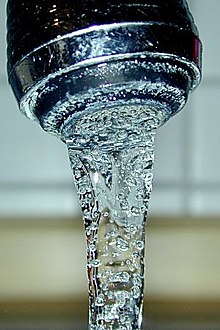Water supply
Water supply is the development and provision of drinking water and service water .
Technology and organization
In technical terms, this is the construction and operation of plants
- for the extraction of raw water , e.g. B. from wells (see also groundwater ), spring water , surface water from lakes , rivers or ponds , collecting rainwater in cisterns ,
- for processing the extracted raw water into drinking water or service water,
- for water distribution , e.g. B. water pipes , intermediate storage z. B. elevated tanks , pumping stations , pressure boosting systems ,
- for extinguishing water supply ,
- for hot water supply .
From an organizational point of view, the appropriate structures must be created to handle these measures. These can be individuals and companies or legal persons . Furthermore, special constructions were introduced in individual states to guarantee public water supply. In Austria these tasks are taken over by the water cooperatives and water associations , in Germany by the municipalities or water associations or utility companies organized under private law, most of which are majority-owned by local authorities. In Switzerland , the water supply is the responsibility of the cantons . These delegate the supply mandate to the municipalities and give them considerable freedom of choice in this regard.
The technical framework for water supply in Germany is based on the DVGW set of rules , in Switzerland on the SVGW set of rules and in Austria on the ÖVGW set of rules . A water safety plan can support the water supplier in risk analysis and risk assessment, but can also encourage quality assurance in the company.
In coastal dry areas, seawater desalination also contributes to the water supply.
history
For information on water supplies from ancient to medieval times, see Water Art and Bucket Wheels .
In Germany, the Hanseatic city of Hamburg received the first modern water supply in 1848 , Berlin followed in 1855, Magdeburg in 1859. Most other cities followed in the 1860s and 1870s. In England a water supply was set up as early as the 1840s, and Vienna received the first high spring pipeline from the Schneeberg area in 1873 . A second high spring pipeline from the Hochschwab area followed from 1900 to 1910. This aqueduct has a length of around 170 km. The presence of a water supply meant that fire fighting could be carried out much faster and with less effort by drawing water from hydrants .
See also
- Specialist group drinking water supply : Technical relief organization - disaster control
- Remote water supply
- International water center
- Urban water management in Germany
- Drinking water network
- Street fountain in Berlin
- Water as a commodity
literature
- Hanns-Peter Mederer: The best is just good enough. How the people of Munich get their spring-fresh water . In: Charivari 3-4. 1999. pp. 35-37 .
- Hans-Jürgen Leist: Water supply in Germany - criticism and possible solutions. oekom Verlag, Munich 2007. ISBN 978-3-86581-078-6
- Hanno Trurnit: History (s) behind the tap - Of water art and waterworks. Frank Trurnit & Partner Verlag GmbH, Ottobrunn 2006. ISBN 3-9806986-6-1
- Shahrooz Mohajeri and Noyan Dinckal: Central water supply in Berlin and Istanbul. Establishment, diffusion and acceptance processes in comparison . In: Technikgeschichte, Vol. 69 (2002), H. 2, pp. 113-147.
Web links
- Martin Illi: water supply. In: Historical Lexicon of Switzerland .
- Water supply in ancient times
- Frontinus Society: Publications on water supply from antiquity to the present (pdf) (195 kB)
- Radio lecture by Wolfram Mauser "Das Blaue vom Globus" about a better water supply
Individual evidence
- ^ Drinking water Switzerland ( Memento of March 12, 2005 in the Internet Archive )
- ^ NN: Die Stadt Graz - published on the occasion of the eighth centenary in 1928, self-published by the City of Graz , p. 272.
- ^ Franz-Josef Sehr : The construction of the first aqueduct for Obertiefenbach . In: Yearbook for the Limburg-Weilburg district 1999 . The district committee of the district of Limburg-Weilburg, Limburg 1998, p. 274-276 .


